|
|
Post by rainforest on Jan 22, 2009 7:38:36 GMT -10
I'm praying for a female!
M
|
|
|
|
Post by ep on Jan 26, 2009 12:12:45 GMT -10
Hi All,
Sam, It's hard to tell from pics. The plants are still immature and the lowers seem to be a lot like others I've seen. The leaves and other plant parts may need to be examined to give a better idea. If you read the type description and also look at Kurata's, Nepenthes of Mt.Kinabalu, it will give you an idea.
There may be a bit of N.fusca in them but without looking at the other plant parts it's hard to tell.
Also if you breed with it you will see some variation in the progeny if it's a hybrid.
Cheers,
Geoff
|
|
|
|
Post by unclemasa on Jan 26, 2009 15:24:03 GMT -10
Hi Geoff .... I looked at Kurata's book and just above the given description he says this .... "This species is distinguishable from others by its upper pitcher which is funnel shaped and peculiarly contracted just below the mouth, and its lid delicately waved at the margin." This seems to fit.  He does not repeat this bit of information in the description but he does say ... " upper pitchers ... mouthy orbiculate, almost horizontal in front, elevated towards the lid". This seems to fit.  I looked through a couple of other sources and, after reading them all and looking through the pictures, I see nothing that makes me doubt the integrity of this particular plant. On another N. burbidgeae note .... Flora Malesiana .. Cheek & Jebb " Nepenthes burbidgeae ..... Upper pitchers ..... lacking fringed wings but with two prominent ridges .." While the photos in Clark's Nepenthes of Borneo, Steiner's Borneo, Kurata's Nepenthes of Mount Kinabalu and even Susan M. Phillipps painting in Pitcher Plants of Borneo show uppers with reduced but distinct "fringed wings".  |
|
|
|
Post by ep on Jan 27, 2009 21:01:42 GMT -10
Hi All, Sam, I guess that is the problem with monographs and their interpretations. Different people can have different interpretations of what they read. It would be great if monographs had diagnostic colour photos with them. My comment was based on seeing your upper pitchers and thinking something is not quite right with them. I then recalled the horizontal mouth of the photo of the upper pitcher in Kurata's book. I then read Jebb abd Cheek's Flora Malesiana and their description of an orbiculate mouth that is horizontal, rising abruptly at the rear to the neck is how I interpreted the description. No doubt there is some variation in plants and I assume all N.burbidgeae and most other species actually, are from wild collected seed and due to this I pose the question: If it is variation, what causes it? Anyway below is a photo of an upper on one of our plants for comparison. Cheers, Geoff 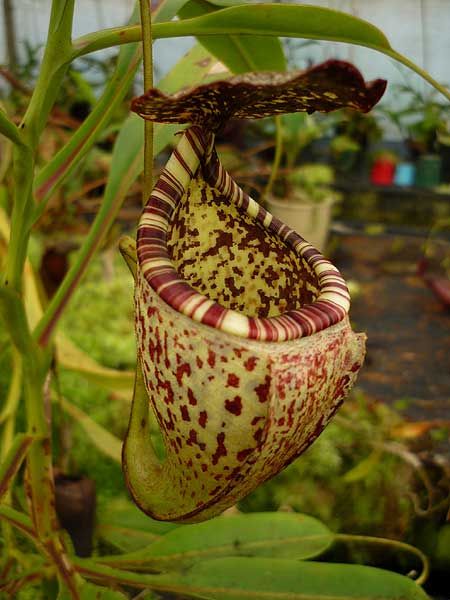 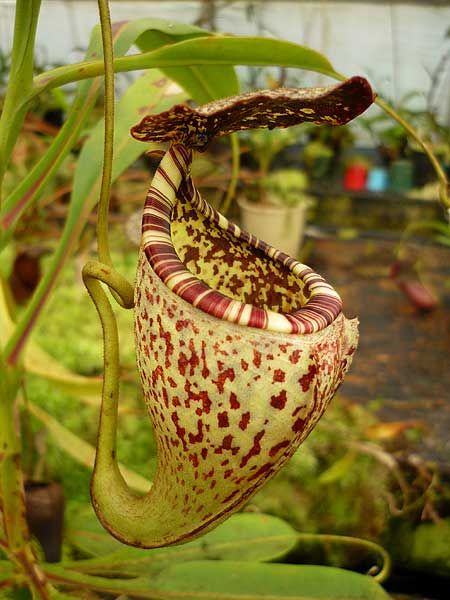 And for comparison:  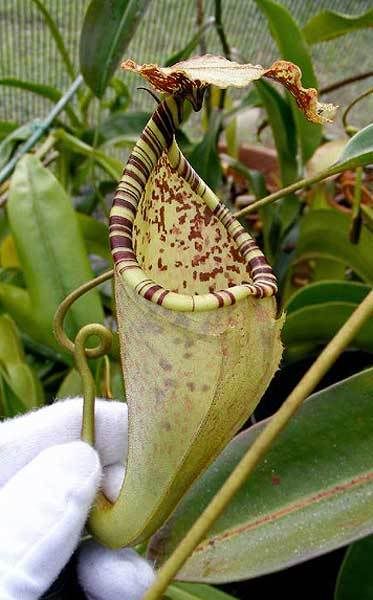 |
|
Dave Evans
Nobiles
   dpevans_at_rci.rutgers.edu
dpevans_at_rci.rutgers.edu
Posts: 490
|
Post by Dave Evans on Jan 28, 2009 0:17:43 GMT -10
Hello Geoff and Sam,
It look like Geoff's plant has a more "classic" shape, but on Sam's the keel seems more developed. It looks like a trade off in characteristics. Both plants look like convincing N. burbidgeae to me.
I think there are different populations of these species. For example, there are five populations of N. rajah, so I'm sure the species can show more diversity than we have seen this far. I doubt N. burdidgeae is any different in this respect...
|
|
|
|
Post by ep on Feb 3, 2009 14:29:39 GMT -10
Hi All,
I suppose it comes down to a good eye and interpretation of the descriptions as already mentioned.
Dave: What you call 'classic' I would call the 'type' shape.
What you call a 'trade off in characteristics', I would ask what you are trading with and call them hybrid influences.
Yes there probably is different populations so more chances of hybridization.
Cheers,
Geoff
|
|
Dave Evans
Nobiles
   dpevans_at_rci.rutgers.edu
dpevans_at_rci.rutgers.edu
Posts: 490
|
Post by Dave Evans on Feb 3, 2009 15:31:03 GMT -10
Dear Geoff, I don't think diversity *has* to come from hybridization, but it does help  |
|
|
|
Post by unclemasa on Feb 5, 2009 22:25:13 GMT -10
Hi Geoff, Unfortunately, I think there is plenty of room for interpretation in many Nepenthes descriptions. This is especially true of older descriptions where they have been based upon limited or incomplete materials. Kurata's description is admirable and he is to be commended for his rigor and attention to detail. Still, by the time of Cheek and Jebb's revision they could say ..... “....this species is represented by only a few incomplete sheets: we have found no fertile material of N. burbidgeae and lower pitchers are represented by only two collections.” This brings us to Clarke’s treatment in Nepenthes of Borneo. Clarke too does an admirable job but, as far as I can tell, adds no new criteria to his description. Still, the pictures from Clarke look more like the specimen you posted above. On the other hand, here is an even more recent picture from Ch'ien Lee's website that looks more like my plant .... www.borneoexotics.com/images/High%20Res/burb_u4M.jpgThere is the possibility that the plant I posted might be a combination of N. burgidgeae and, maybe, N. fusca somewhere along the line as, I understand, there have been recorded natural hybrids of this nature. Perhaps, the plant will give us some further clues as it matures and then I might be inclined to consider the possibility seriously. However, without further evidence .... the plant easily fits within the given descriptions I have read. |
|
|
|
Post by michelle on Feb 6, 2009 3:10:31 GMT -10
I agree with Exotica, the N. burbidgeae in Sam's photo is a hybrid, in my opinion. The lid was not mentioned in this discussion, but it's obviously not the same shape. Sam's plant has a slightly more narrow lid. True N. burbidgeae has a round shaped lid. Sam's plant looks like a fusca hybrid, perhaps fusca as a grandparent.
Dave Evans said "the keel seems more developed on Sam's photo" ****which could be from N. fusca as well.
According to Danser "lid is broadly ovate, undulate at the margin, the underside wholly glandular, the basal part of the midrib is keeled."
The other, more significant feature I noticed: The area directly below the peristome should have an indented band or "line" connecting the peristome to the outside of the pitcher body. N. khasiana also has a similar feature (it would be where the white band would occur in N. albomarginata).
Sam's plant does not have this line or band.
EP's pic of the true species does show this feature, as well as all the photos we have seen of the true N. burbidgeae uppers (not as prominent on lowers because it's hidden by the recurved peristome). This feature is also clear to see in the Ch'ien Lee photo.
-
Michelle
|
|
|
|
Post by sockhom on Feb 6, 2009 7:15:15 GMT -10
Michelle, Welcome from me  . François. |
|
|
|
Post by unclemasa on Feb 6, 2009 23:23:29 GMT -10
Welcome Michelle!
Geoff may be right. He certainly has a sharper eye for these details that I do.
Still, the plant I posted fits well within the letter of the published descriptions. This, however, may speak to the deficiencies of the taxonomic descriptions rather that the purity of the genetic line. I remain open to this argument and, hopefully, as the plant further matures it will present some sort of definitive evidence one way or the other but, so far, the qualities mentioned seem interesting but not at all compelling.
I've got other specimens of N. burbidgeae and would actually be pleased if I could say for sure that I was owner of a very rare natural hybrid of N. burbidgeae and N. fusca ( ... perhaps the only specimen in cultivation .... ?). In studying this plant I have read cursory mention of the existence of such a hybrid (Clarke) but nothing more.
|
|
|
|
Post by ep on Feb 7, 2009 3:03:44 GMT -10
Hi All, It's funny the path these species discussions take  Firstly I am not trying to convince anyone anyway. I am just presenting the facts how I see them from growing Neps for many years. I really don't like jumping in and bringing up these points when someone is presenting their plant that they bought as N.sp whatever but at times I am compelled to do so. I mean no offense and am just trying to keep the integrity of the species in question based on my knowledge and observations over the years. My intention is to help. Also I can be incorrect and if so I have gained some knowledge. Regarding your plant in question Sam, there is one thing that no one has mentioned or just overlooked in every monograph and that is the colouration. N.burbidgeae has a white/porcelain pitcher with red/purple splotches on the outside. The photo of Chien Lee/BE's plant also shows these markings. Below is a photo of an intermediate pitcher and lower pitcher from the same plant that I posted the photos of the uppers. You can see the intermediate has a similar shape to your upper but has the typical colour. The lower pitchers you also posted of the other plant do look true to type. The lid is a bit odd but these plants could be still immature. Please post some photos of the plant parts if you would like to see if these fit. BTW. Where did you obtain these plants from originally? Cheers, Geoff 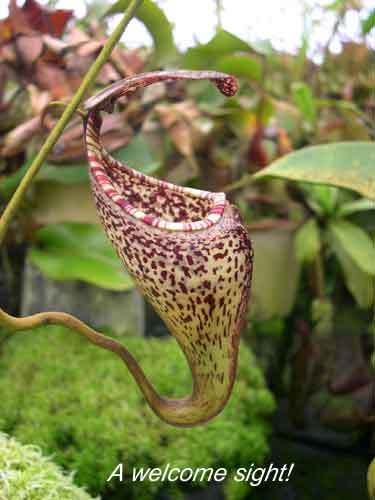 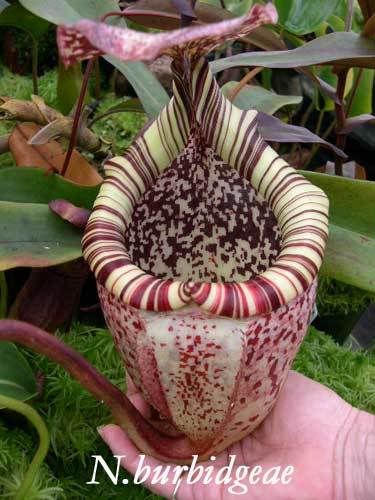 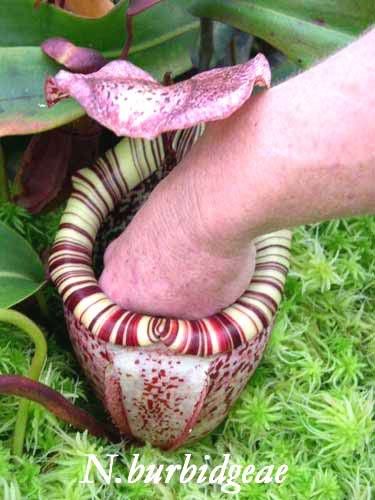 |
|
|
|
Post by michelle on Feb 7, 2009 3:59:30 GMT -10
Welcome Michelle! Still, the plant I posted fits well within the letter of the published descriptions. This, however, may speak to the deficiencies of the taxonomic descriptions rather that the purity of the genetic line. I remain open to this argument and, hopefully, as the plant further matures it will present some sort of definitive evidence one way or the other but, so far, the qualities mentioned seem interesting but not at all compelling. Francois, Thanks for the welcome here.  Sam, As I said in my previous post: The area directly below the peristome should have an indented band or "line" connecting the peristome to the outside of the pitcher body. N. khasiana also has a similar feature (it would be where the white band would occur in N. albomarginata). *** Sam, do you understand what I am trying to describe? One of our local friends is a taxonomist and he also grows Nepenthes. He informed us the line under the peristome is a stable feature and should be there for this species. The line on Sam's plant looks like it's diluted. I am not just making this up out of the blue. This was from a discussion with a taxonomist. |
|
|
|
Post by unclemasa on Feb 7, 2009 21:44:33 GMT -10
Geoff .... Of course. I'm honored that you would devote me the attention. Never fear that pointing out my errors will endanger our friendship. Michelle .... I am glad to be hearing from you again. I do know what your talking about ... the marginate area below the peristome. YOU GUYS HAD ME GOING!
I was perfectly confident in this plants ID
Geoff said "It does not look right to me"
Maybe some fusca got mixed in
the marginate area looks too thin
The lids is too pointy and the edges too wavy
Now I'm beginning to think "Maybe?"
The angles are off and the slope is not right
So I'm reading descriptions, up late at night
Kurata and Clark, Danser, Jebb and Cheek
A few hours with these guys feels like a week
There I am .... still in doubt
Is it the fusca hybrid Clarke talked about?
So I think to myself, this wouldn't be bad
A rare natural hybrid would not make me sad
Back to the nursery to look at my prize
Take some more pictures to show to these guys
But there will be no joy in the nursery today
It's no rare hybrid ... just old burgidgeae. |
|
|
|
Post by michelle on Feb 8, 2009 4:25:40 GMT -10
Sam,
You really think it's the pure species?
Wow, I guess Geoff was mistaken...
You can lead a horse to water...
Call that thing whatever you want, whatever makes you happy, man.
You sold "echinostoma" and "eustachya" for years before you finally agreed they were not.
Your poem is very creative.
Bye.
|
|